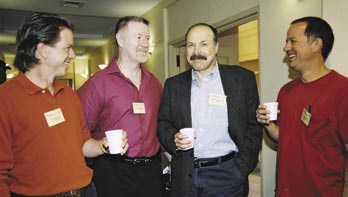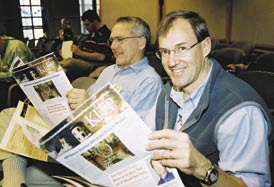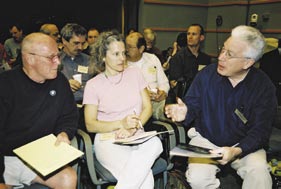 Teacher Conference participants, dressed casually in reds for the Santa Barbara event, Jon Anderson (l) from Minnesota, Randall Dunkin from Ohio, and Mark Toney from Washington (state) with conference organizer David Awschalom. Photo by Nell Campbell.
Teacher Conference participants, dressed casually in reds for the Santa Barbara event, Jon Anderson (l) from Minnesota, Randall Dunkin from Ohio, and Mark Toney from Washington (state) with conference organizer David Awschalom. Photo by Nell Campbell.
Some 70 teachers of physics came from throughout the United States to the KITP’s fifth conference for high school teachers — this one on “Nanoscience and Quantum Computing.”
David Awschalom, an experimentalist who directs the Center for Spintronics and Quantum Computing at UC Santa Barbara, put together the program for the March 24 KITP Teachers Conference in conjunction with his role as an organizer of the KITP “Spintronics” conference and program for physicists (March 13 to June 23).
 Teachers Wayne Hild and Dan Stewart from California. Photo by Nell Campbell.
Teachers Wayne Hild and Dan Stewart from California. Photo by Nell Campbell.
The spring programming for physicists at the KITP determines the topic for the annual Teachers Conference. Not only can attendees of the physics programs be tapped as speakers, but also, even more importantly, the tie-in to current KITP programming ensures that what the teachers hear is what is happening in physics now.
As one teacher commented, “At the high school level we are largely concerned with 16th century physics (mechanics, etc.). It’s great to get to hear research being done on some really exciting physics.”
According to another teacher, “This type of conference is the most valuable in-service I have attended in 18 years of teaching. We are starved for information on cutting-edge science. To hear it from the top researchers in the world is a great treat.”
 Teachers Ed Kunitz (l) from Illinois, Patricia Spackman from Pennsylvania, and Steve Buster from Kansas. Photo by Nell Campbell.
Teachers Ed Kunitz (l) from Illinois, Patricia Spackman from Pennsylvania, and Steve Buster from Kansas. Photo by Nell Campbell.
The top researchers who entranced the teachers are Robert Buhrman of Cornell, James Eisenstein and John Preskill of Caltech, Stephan von Molnar of Florida State University, and Stuart Wolf of the University of Virginia.
“I wanted speakers,” said Awschalom, “who could communicate effectively to both the public and to high school teachers, and were also leaders in their fi eld, so that 'de facto' they are excited by what they are doing.”
The presenters’ enthusiasm for their research was contagious, as the responses of the following four teachers indicate:
- “Only my second time to attend, but this has been the most valuable workshop I’ve ever attended in the way it affected me personally. I was revitalized.”
- “This type of conference rejuvenates our interest in Modern Physics. Thank you for inviting us teachers.”
- “I can use some of the info in class. But I love being brought up to date. This is energizing to me.”
- “Re-energized my passion for physics.”
Other teachers noted the benefits to their young students:
- “These types of conferences are very unique and most informative in regard to ‘frontiers of science.’ I find them most helpful. My students always look forward to my return to tell them about what I have discovered and learned in science.”
- “This is the best part of my year. I bring back excitement and knowledge, which I cannot get elsewhere.”
- “I teach locally and have attended 3 of these conferences. I have incorporated certain topics into my teaching (e.g., brief coverage of string theory when covering make-up of matter and energy). Plus each conference inspires me to a higher level of excitement in my own continuing study of physics.”
- “Both of the conferences I have attended have reinvigorated my teaching.”
- “This series of conferences has been the best I’ve ever attended. I have used almost every presentation in my classes.”
- “Many good ideas for bringing modern topics to the classroom were discussed. More so, the talks were of great personal interest.”
Of the 70 teachers attending, 44 put their responses to the March 24 experience in writing. Their overriding message was one of gratitude for being revitalized and connected with physics as a live, rather than a dead, enterprise.
Each of the comments quoted in this article is from a different respondent to the question “Do you feel this type of conference is of value to your teaching?” Here are four more:
- “It is of extreme value to physics teachers. This is one of the best connections between high school teachers and the science and technology of the day.”
- “It is very important to bring current topics into your teaching.”
- “One of the top (perhaps the best) ways of communicating state-of-art science (both content and methodology) to teachers.”
- “Science teachers need to be with scientists as part of our regular routine.”
- “Definitely one of the best opportunities I’ve had to expand my content knowledge in physics.”
In addition to being available for the first time as a Podcast, the whole Teachers Conference, in audio only or in audio-visual format, can be accessed via the KITP web site at http://online.kitp.ucsb.edu/online/spintr2_c06/.
Since the teachers’ comments indicate that a little effort does, in some cases, go such a long way, please consider alerting high school physics teachers to this resource.
